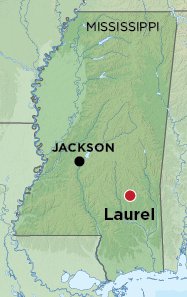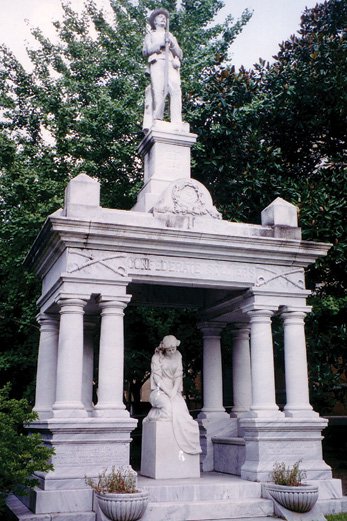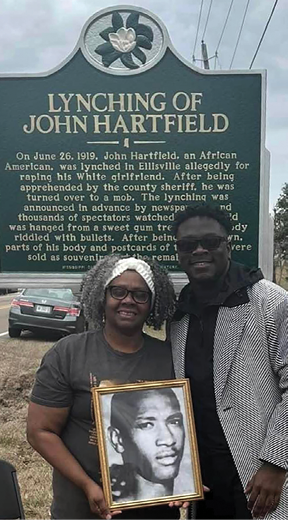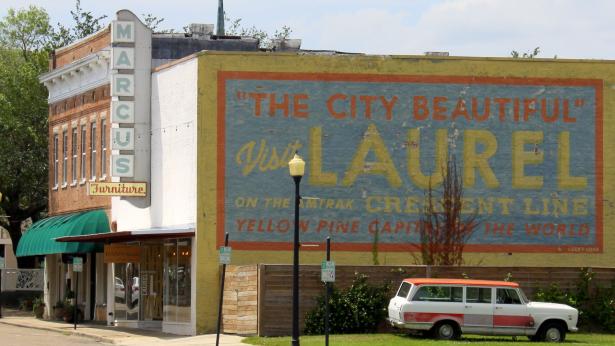When I tell people where I grew up, they say, “Oh, is that the Laurel, Mississippi, on HGTV?” Then they gush, “It sounds just like Mayberry!” parroting one of the perky hosts on the blockbuster home improvement show Home Town.
I suspected the show was repackaging my memories for popular consumption, because my Laurel was no Mayberry. As far as I know, the fictional TV utopia wasn’t 69 percent people of color with some of the highest rates of poverty and crime in the nation, not to mention being home to some of the most horrific acts of racism in the South.
Here’s a snapshot of the Laurel I knew: On May 8, 1951, while my mother was waiting to give birth to me at the town’s Masonite Clinic, only six blocks away at the courthouse, Willie McGee, a Black man, was being legally lynched to the cheers of more than a thousand white citizens.
A few blocks east lived a business owner and Sunday school teacher named Sam Bowers, soon to become the Ku Klux Klan imperial wizard of Mississippi Burning fame. The FBI later investigated Bowers, and he was charged alongside several other pillars of our community—including the Jaycees’ 1968 Young Man of the Year—with carrying out another atrocity of the civil rights era: firebombing the home of voting rights activist Vernon Dahmer, killing him. We were told by our community leaders to put these incidents behind us and never speak of them again, and we white residents did. Most still do.
In the 1970s, the city fell victim to the trends besetting most small Southern towns after integration. Private segregation academies arose so that white students could avoid going to school with Black students. White residents fled the city limits into the county, and housing values plummeted. No longer confined to the other side of the tracks, the newly emerging majority could move into neighborhoods where they were once welcomed only as domestic or yard workers.
The mass exodus of white people left Laurel with a diminished tax base and decaying infrastructure. The downtown district suffered, and houses and entire neighborhoods fell into disrepair. Eventually, the downtown area and the seven-block historic district dominated by magnificent mansions built by lumber barons became a shrinking white sliver in a predominantly African American pie.

When I visited in 2015 to bury my mother, what wasn’t already dead in the city seemed to be on life support.
That’s what an HGTV crew saw when they arrived in Laurel that same year: A down-and-out city in dire need of saving—with plenty of cheap housing stock—and not least, an unsavory history of racism, violence, and economic oppression that badly needed a makeover.
After binge-watching several seasons of Home Town, I have to admit, I saw the draw. By restoring Laurel one house at a time, the hosts claim to be building a close-knit, values-driven community that hearkens back to the idealized past that white people like to picture. After watching, even I was longing for this Laurel that never existed.
The hosts, husband-and-wife team Ben and Erin Napier, certainly seem like lovely people, and it is hard to doubt their sincerity. Still, I was left asking, “Where did two-thirds of the population up and go? Where did you hide the pervasive poverty? In what closet did you cram the racist history of my hometown?” It seemed to me that they were not so much restoring my town as “re-storying” it.
I decided it was time to pay a visit to my birthplace—as a tourist.
If you take the recommended exit, Interstate 59 will ease you comfortably into the historic district, the focus of much of Laurel’s restoration. This route conveniently bypasses areas of mostly poor people of color living on potholed streets lined with neglected and abandoned properties—neighborhoods that scare white people senseless.
Yet the transformation of the downtown area startled me. Once shabby and nearly entirely boarded up, the city center was now all spiffed up and bustling. Long-defunct businesses where my family had purchased clothes, hardware, and school supplies and gone to see Elvis movies were elegantly transformed into restaurants, coffee shops, upscale art studios, luxury lofts, and gift boutiques. The façades were familiar, but the goods advertised were too exotic for a Southern town of less than 20,000 people, leaving me disoriented.
As I walked the crowded sidewalks, I even overheard a few Yankee accents. But unlike the place of my youth, there were no Black faces. To my amazement, the town seemed more segregated than it had been in the 1960s. Post Home Town, Laurel does look a little like Mayberry.
But from watching the show, I knew there was at least one Black-owned business downtown. Pearl’s Diner now occupies the former jewelry store where my father once purchased a diamond ring for my mother. The face of Pearl Campbell, a grandmotherly Black woman, is featured conspicuously on the show and most media profiles, as if to make a point. I paid a visit, and the food was as good as your favorite Southern aunt’s Sunday dinners. Yet there were no Black customers—only cooks and servers.
As for other Black-owned businesses, that was about it. If the show was supposed to trickle down wealth to the impoverished third of the city, I failed to see it. Downtown looked more like Gentrified Town than Home Town. And again, so damn white!
As I exited the diner, there appeared another astonishing sight: a trolley with an actual tour guide offering to show tourists around town. I hopped on for the $25 tour.
All seven of us were white, except for the guide, a gregarious Black woman with a quick wit who was also raised in Laurel. I took the seat next to her and quickly discovered that she and I had gone to the same high school, although more than thirty years apart. The same but different. My school, by Mississippi law, was white. By the time she began, white flight had converted her entire graduating class to people of color.
As we putted along the streets of the white neighborhoods of my youth, I could see more substantial changes the show had brought about since its debut in 2016. Once grand but ramshackle houses had been returned to a condition the original owners, more than a century earlier, could behold with pride.
The guide stopped in front of each restoration, but before she could utter a word, my fellow trolley mates—who hailed from all over the country plus Canada, and all of whom were dedicated fans of the show—beat her to the punch, reciting the name of the house and the owners, not to mention during which season it had aired. And, of course, we had to stop at all the cute businesses in the Home Town money-making franchise: a clothing store, the mercantile gift shops, all carefully stocked with the tourist in mind.
We were thirty minutes into the tour and had not once strayed out of the bubble of whiteness that is the purview of Home Town. So far, the guide had not mentioned the landmark civil rights struggles, the KKK, Black martyrs, or the crucial role that race played in the shaping of Laurel. She didn’t point out the church where the Reverend Martin Luther King Jr. had preached and which had survived a 1967 KKK bombing. She mentioned Laurel native and Metropolitan Opera star Leontyne Price, but not that Ms. Price’s aunt had once worked as a maid in one of the mansions we had just passed.
As we approached the courthouse, I was certain the weight of history would force her to mention the multiple lynchings and the monstrous Confederate monument that dominated the lawn. Surely, she couldn’t sidestep that.
Just as the courthouse came into view, she adeptly directed our group’s attention to the Methodist church across the street. I had underestimated her skill at putting white folks at ease. No one seemed to notice the sleight of hand.

Jonathan Odell
The Confederate monument on the courthouse lawn in Laurel, Mississippi, was not featured on the local sightseeing trolley tour.
To be clear, I’m not criticizing our guide. These tourists weren’t paying to hear about racism or structural poverty. They came to bask in the glow of their favorite feel-good television show. White tourism not only brings in money for the white investors and the nearly exclusively white business owners, but it also puts needed tax dollars into the city’s coffers, which still haven’t recovered from white flight.
Nor do I begrudge the show’s hosts, the Napiers. To their credit, the carpenter-designer duo seem sincere about what they are doing. They do their bit for charity by promoting worthy causes on and off the screen once in a while, and they renovate houses for Black couples, gay couples, and mixed-race couples. The cynical part of me thinks that these gestures give their white audience permission to enjoy a show based in a state known for its notorious racism and religious intolerance without feeling complicit. Guilt-free entertainment sells.
Yet I believe Home Town should give fair warning to people of color, liberals, or queer folks who might otherwise be charmed into moving to Laurel. When they venture out of the show’s cozy, white bubble, it’s a different world. I’d advise them to take out a subscription to the local paper. The Laurel Leader-Call features regular columns written by slavery minimizers, ranting homophobic preachers, Klan defenders, and Confederate loyalists.
As popular as the city booster club is the local Sons of Confederate Veterans, which the Southern Poverty Law Center says is linked to several white supremacist groups. But that doesn’t stop the town from cheering for them as they commandeer the courthouse square on Confederate Memorial Day with their flags, guns, and Confederate uniforms.
Here’s the truth I know about Laurel: The most race-baiting politicians in Mississippi find fertile soil in the stomping grounds around my hometown. After the publisher of the town paper called Black Lives Matter a “Marxist terrorist hate group” in the summer of 2020, white men volunteered to serve as snipers atop city buildings to keep a handful of peaceful Black Lives Matter marchers in line. A contingent of Oath Keepers stood guard with their automatic weapons to protect the Confederate monument from local descendants of the enslaved.
That’s not history; that’s today. The show addresses none of this. Perhaps they were filming in another part of Mayberry, or more likely, covering this kind of story—or bemoaning the plight of the homeless and oppressed in their midst—would mean losing viewership. It’s not that the story the show tells about Laurel is untrue; it’s just incomplete. Worse, it papers over the experience of an entire people—again.
History in Laurel, like in the rest of the United States, is still segregated. If you came to hear the Black story, you’ll need to go elsewhere.
As luck would have it, while I was visiting I learned there would be a grand opening celebration for the Laurel-Jones County Black History Museum and Arts. The museum is the creation of Marian Allen. Bubbly and persistent, she is a formidable force for advancing the history of Black folks in Laurel.

Halle Grace Allen
Marian Allen stands with her godson Jalen Lindsey in front of the historical marker commemorating lynching victim John Hartfield. Allen is holding a photo of Hartfield.
Allen told the audience how, for a long time, she traveled with all of her Black history artifacts in the trunk of her car, setting up mobile exhibits anywhere people would have her—churches, schools, public spaces. Finally, thanks to small dollar contributions, she was able to purchase a rambling, long neglected house to display her collection—a house, incidentally, that she and her mother had cleaned when she was a child. On the walls hung photos of Black Laurel’s heroes: Olympic Hall of Famer Ralph Boston; Leontyne Price, the Metropolitan Opera soprano, and her brother, Brigadier General George Price, the children of a midwife; and other nearly forgotten civil rights activists and martyrs.
She doesn’t shy away from the ugly and violent parts of history. Her museum raised the money and successfully lobbied the Mississippi Historical Society to erect a marker for one of the county’s many lynching victims. The marker represents the first public acknowledgment of John Hartfield’s murder; he was accused of dating a white woman. Many people, Black and white, tell her it never happened or that she should just “let it alone.” Of course, the marker is well out of sight of the white tourists, because, well, there’s no such thing as lynching in Mayberry.
I doubt Allen will find her way onto the show without heavy editing. Though she delivers her message in the most congenial, entertaining way possible, her work makes many white people uncomfortable.
I left Laurel with mixed feelings about the show. On the positive side, the work the hosts have done is visually stunning and in true character with the original architecture. While in the coffee shop, I overheard locals talk as if Laurel was on the cusp of a great transformation. I spoke with a couple from Newfoundland who, after watching the show, were planning to retire in Laurel.
I’d love to see more amicable mingling between Northerners and Southerners—but also between Black folks and white folks, Hispanic folks and Indigenous folks, liberals and conservatives, the documented and the undocumented, queer folks and straight and trans and bi. But I don’t think that’s the community the show’s hosts or the money backers have in mind, at least not in large doses.
Instead, the show suggests to its white, middle-class demographic that Laurel is a financially comfortable white community without a troubling past, simmering race issues, sky-high crime rates, or 59 percent of children living below the poverty line—a utopia where the only conflict is whether to wallpaper the entryway or paint it. They are promoting small-town nostalgia to a white audience hungry for a past that never was while obfuscating the past that is.
The show, not Laurel, is the draw. Sooner or later, the hosts will take their cameras and pleasing personalities to the next town, leaving little sustainable behind. As I drove out of town, I had the feeling of déjà vu—that we’ve been here before and that, for all the hype, this is nothing new.
The last time Laurel had a bustling, prosperous downtown was during the era of legal segregation, when all the businesses were owned and operated by white people. Schools, like now, were segregated. We had an underclass of dark-skinned people quartered out of view so they couldn’t blemish the image of the town that locals like to call “City Beautiful.” Today, like then, tax revenues are funneled into projects that primarily improve the lives of white folks, while Black areas are left to suffer neglect, high crime, and a sixty-year-old flooding problem so severe that sometimes Black residents have to leave their homes by boat. Once more, it seems we have created a gorgeous white bubble for a privileged few while obscuring the lived truth of the most marginal.
I could be wrong. It’s true that the population of Laurel is still shrinking, the poverty rate has barely budged, and the national attention brought by the show is driving up housing prices for those who can least afford it. Still, maybe one day the show will be bold enough to broach income inequality, structural racism, and the harm done by our selective sense of history. Perhaps the show’s makers will sponsor not only a tour of white Laurel but also tell how white Laurel would not exist without Black Laurel, and how our histories are interwoven. Instead of shooing off the homeless before filming, they could use a wide-angle lens and expand Laurel’s sense of community to include the disenfranchised and systemically forgotten folks surrounding them.
It wouldn’t remind anyone of Mayberry, but it would be a show worth watching.
Jonathan Odell is the author of three novels, and his essays and short stories have appeared in The New York Times, Commonweal, Publishers Weekly, the Baltimore Review, the Utne Reader, and elsewhere. He lives in Minneapolis with his husband.
Since 1909, The Progressive has aimed to amplify voices of dissent and those under-represented in the mainstream, with a goal of championing grassroots progressive politics. Our bedrock values are nonviolence and freedom of speech. Based in Madison, Wisconsin, we publish on national politics, culture, and events including U.S. foreign policy; we also focus on issues of particular importance to the heartland. Two flagship projects of The Progressive include Public School Shakedown, which covers efforts to resist the privatization of public education, and The Progressive Media Project, aiming to diversify our nation’s op-ed pages. We are a 501(c)(3) nonprofit organization. Donate


Spread the word